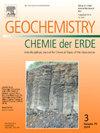Origin and evolution of vanadium (V) enrichment in Azıtepe (Alaşehir-Manisa) meta-gabbroic rocks in Menderes massif (Western Turkiye)
IF 2.9
3区 地球科学
Q2 GEOCHEMISTRY & GEOPHYSICS
引用次数: 0
Abstract
The Azıtepe meta-gabbroic intrusions, located in Alaşehir, Manisa (western Turkiye), represent part of the Late Neoproterozoic gabbroic bodies that emplaced along the northern margin of Gondwana within the central Menderes Massif, and host Fe-Ti-(V) oxide mineralization. These gabbroic intrusions generally originated from a tholeiitic mantle source, and have minimal evidence of crustal contamination, as indicated by high Nb/U (30–166.7) and Nb/Th (9.37–58.3) ratios, along with low Pb concentrations. However, the mechanisms governing vanadium (V) enrichment in such Fe–Ti–(V) systems, particularly the role of metamorphic overprinting in V redistribution, remain poorly understood. This study aims to determine the processes responsible for V enrichment in Fe–Ti–(V) oxide minerals within the Azıtepe meta-gabbroic intrusion by evaluating V partitioning and mineral hosts in relation to magmatic and metamorphic controls. The ore mineral paragenesis includes Ti-magnetite, magnetite, ilmenite, rutile, hematite, goethite, pyrite, chalcopyrite, and pyrrhotite. In this study, V mineralization is observed in oxide minerals such as magnetite, Ti-magnetite which are influenced by both magmatic crystallization and subsequent metamorphic alteration. The Azıtepe meta-gabbroic rocks generally show enrichments in Fe₂O₃(t) (10.2 to 18.5 wt%) and TiO₂ (2.04 to 6.50 wt%). The V concentrations of the studied rocks range from 355 to 473 ppm in meta-gabbros while varying between 217 and 628 ppm in amphibolites. EPMA (Electron probe microanalysis) data indicate that V is preferentially incorporated into magnetite rather than ilmenite in meta-gabbros and garnet-free amphibolites, likely due to its compatible ionic radius and charge relative to Fe3+, a behavior that supports its preferential partitioning into magnetite under moderate to high fO₂ conditions. The formation conditions of magnetite–ilmenite pairs in meta-gabbro and amphibolite samples from the study area were evaluated using EPMA-derived equilibrium data processed through the MagMin_PT software, and its application was extended to metamorphic samples in this study. The studied samples' log fO2 values (−13.7 to −28.1) may be pointed out moderately to strongly reducing conditions with textural context guiding interpretation. In garnet-bearing amphibolites, however, variations in metamorphic conditions (P, T, fO₂) and/or hydrothermal alteration may have mobilized previously magnetite-hosted V, facilitating its redistribution into silicate minerals such as garnet, chlorite, and clinozoisite. These results suggest that V enrichment in the Azıtepe meta-gabbroic rocks is primarily controlled by magmatic processes under moderately oxidizing conditions, with secondary redistribution during metamorphism, highlighting the potential of such intrusions as significant sources of Fe–Ti–V mineralization in post-collisional tectonic settings.
土耳其西部Menderes地块Azıtepe (ala eir - manisa)变质辉长岩中钒(V)富集成因与演化
位于土耳其西部马尼萨ala ehir的Azıtepe变质辉长岩侵入体代表了Menderes地块中部冈瓦纳北缘晚新元古代辉长岩的一部分,并具有Fe-Ti-(V)氧化物成矿作用。这些辉长岩侵入体一般来自拉斑岩地幔源,具有较高的Nb/U(30-166.7)和Nb/Th(9.37-58.3)比值,以及较低的Pb浓度,表明其受地壳污染的证据较少。然而,在这种Fe-Ti - (V)体系中控制钒(V)富集的机制,特别是变质叠印在钒重分配中的作用,仍然知之甚少。本研究旨在通过评估与岩浆和变质控制有关的V分配和矿物寄主,确定Azıtepe变质辉长岩侵入体内Fe-Ti - (V)氧化物矿物中V富集的过程。矿石矿物共生有钛磁铁矿、磁铁矿、钛铁矿、金红石、赤铁矿、针铁矿、黄铁矿、黄铜矿和磁黄铁矿。在磁铁矿、钛磁铁矿等氧化矿物中,钒矿化受岩浆结晶和变质蚀变的双重影响。Azıtepe变质辉长岩普遍富集Fe₂O₃(t) (10.2 ~ 18.5 wt%)和TiO₂(2.04 ~ 6.50 wt%)。变质辉长岩的V含量在355 ~ 473 ppm之间,角闪岩的V含量在217 ~ 628 ppm之间。EPMA(电子探针微分析)数据表明,在偏辉长岩和无石榴石角闪岩中,V优先结合到磁铁矿中,而不是钛铁矿中,这可能是由于其相对于Fe3+的相容离子半径和电荷,这一行为支持了它在中高fO 2条件下优先分配到磁铁矿中。利用MagMin_PT软件处理的epma平衡数据,评价了研究区变质辉长岩和角闪岩样品中磁铁矿-钛铁矿对的形成条件,并将其应用到变质岩样品中。研究样品的对数fO2值(−13.7 ~−28.1)可以指出中等到强烈的还原条件,并以纹理背景指导解释。然而,在含石榴石的角闪岩中,变质条件(P、T、fO 2)和/或热液蚀变的变化可能调动了先前含有磁铁矿的V,促进其重新分布到石榴石、绿泥石和斜沸石等硅酸盐矿物中。这些结果表明,Azıtepe变质辉长岩中V的富集主要受岩浆作用控制,并在变质过程中进行了二次再分配,突出了这些侵入体在碰撞后构造环境中作为Fe-Ti-V矿化的重要来源的潜力。
本文章由计算机程序翻译,如有差异,请以英文原文为准。
求助全文
约1分钟内获得全文
求助全文
来源期刊

Chemie Der Erde-Geochemistry
地学-地球化学与地球物理
CiteScore
7.10
自引率
0.00%
发文量
40
审稿时长
3.0 months
期刊介绍:
GEOCHEMISTRY was founded as Chemie der Erde 1914 in Jena, and, hence, is one of the oldest journals for geochemistry-related topics.
GEOCHEMISTRY (formerly Chemie der Erde / Geochemistry) publishes original research papers, short communications, reviews of selected topics, and high-class invited review articles addressed at broad geosciences audience. Publications dealing with interdisciplinary questions are particularly welcome. Young scientists are especially encouraged to submit their work. Contributions will be published exclusively in English. The journal, through very personalized consultation and its worldwide distribution, offers entry into the world of international scientific communication, and promotes interdisciplinary discussion on chemical problems in a broad spectrum of geosciences.
The following topics are covered by the expertise of the members of the editorial board (see below):
-cosmochemistry, meteoritics-
igneous, metamorphic, and sedimentary petrology-
volcanology-
low & high temperature geochemistry-
experimental - theoretical - field related studies-
mineralogy - crystallography-
environmental geosciences-
archaeometry
 求助内容:
求助内容: 应助结果提醒方式:
应助结果提醒方式:


